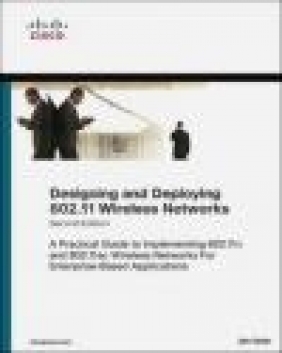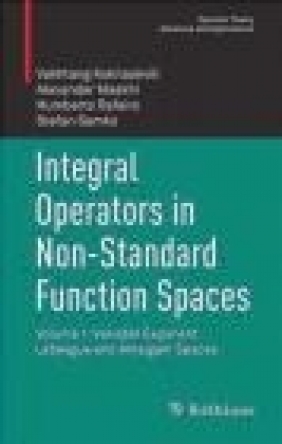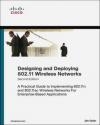Designing and Deploying 802.11 Wireless Networks
Jim Geier
Designing and Deploying 802.11 Wireless Networks
Jim Geier
- Producent: Cisco Press
- Rok produkcji: 2015
- ISBN: 9781587144301
- Ilość stron: 512
- Oprawa: Twarda
Niedostępna
Opis: Designing and Deploying 802.11 Wireless Networks - Jim Geier
Designing and Deploying 802.11 Wireless Networks Second Edition A Practical Guide to Implementing 802.11n and 802.11ac Wireless Networks For Enterprise-Based Applications Plan, deploy, and operate high-performance 802.11ac and 802.11n wireless networks The new 802.11ac standard enables WLANs to deliver significantly higher performance. Network equipment manufacturers have refocused on 802.11ac- and 802.11n-compliant solutions, rapidly moving older versions of 802.11 toward "legacy" status. Now, there's a complete guide to planning, designing, installing, testing, and supporting 802.11ac and 802.11n wireless networks in any environment, for virtually any application. Jim Geier offers practical methods, tips, and recommendations that draw on his decades of experience deploying wireless solutions and shaping wireless standards. He carefully introduces 802.11ac's fundamentally different design, site survey, implementation, and network configuration techniques, helping you maximize performance and avoid pitfalls. Geier organizes each phase of WLAN deployment into clearly defined steps, making the entire planning and deployment process easy to understand and execute. He illuminates key concepts and methods through realistic case studies based on current Cisco products, while offering tips and techniques you can use with any vendor's equipment. To build your skills with key tasks, you'll find several hands-on exercises relying on free or inexpensive tools. Whether you're deploying an entirely new wireless network or migrating from older equipment, this guide contains all the expert knowledge you'll need to succeed. Jim Geier has 30 years of experience planning, designing, analyzing and implementing communications, wireless, and mobile systems. Geier is founder and Principal Consultant of Wireless-Nets, Ltd., providing wireless analysis and design services to product manufacturers. He is also president, CEO, and co-founder of Health Grade Networks, providing wireless network solutions to hospitals, airports, and manufacturing facilities. His books include the first edition of Designing and Deploying 802.11n Wireless Networks (Cisco Press); as well as Implementing 802.1X Security Solutions and Wireless Networking Handbook. Geier has been active in the IEEE 802.1 1 Working Group and Wi-Fi Alliance; has chaired the IEEE Computer Society (Dayton Section) and various conferences; and served as expert witness in patent litigation related to wireless and cellular technologies. *Review key 802.11 concepts, applications, markets, and technologies*Compare ad hoc, mesh, and infrastructure WLANs and their components*Consider the impact of radio signal interference, security vulnerabilities, multipath propagation, roaming, and battery limitations*Thoroughly understand today's 802.11 standards in the context of actual network deployment and support*Plan your deployment: scoping, staffing, schedules, budgets, risks, feasibility analysis, and requirements*Architect access networks and distribution system for maximum reliability, manageability, and performance*Make the right tradeoffs and decisions to optimize range, performance, and roaming*Secure WLANs via encryption, authentication, rogue AP detection, RF shielding, and policies*Master design and site survey tools and methods for planning 802.11ac networks and migrations*Efficiently install and test any 802.11ac or 802.1 1n wireless network*Establish specialized support for wireless networks, including help desk operations*Systematically troubleshoot connectivity, performance, and roaming issues*Design efficient mesh networks and city-wide deploymentsIntroduction xxv Part I: Fundamental Concepts Chapter 1 Introduction to Wireless LANs 1 Wireless LAN Markets and Applications 1 Retail 2 Warehousing 2 Healthcare 4 Hospitality 5 Voice over WLAN 5 Video Surveillance 6 Home and Small Office 7 General Enterprise Systems 8 Location-Aware Wireless Applications 8 Benefits of Wireless Networks 10 Mobility 10 Installation in Difficult-to-Wire Areas 11 Increased Reliability 11 Reduced Installation Time 12 Long-Term Cost Savings 12 Productivity Gain Is the Answer 12 Wireless LAN Technologies 14 Initial 802.11 16 802.11a 16 802.11b 16 802.11g 17 Current Standards: 802.11n and 802.11ac 18 Comparison of 802.11 Standards 19 Wi-Fi Certification 19 Wireless LANs: A Historical Perspective 21 The Early Days 21 Initial 802.11 Standardization 22 802.11n and 802.11ac Standardization 23 Summary 25 Chapter 2 Radio Wave Fundamentals 27 Radio Wave Attributes 27 Amplitude 28 Frequency 28 Phase 29 RF System Components 29 RF Transceiver 29 RF Modulation 30 Amplitude-Shift Keying 31 Frequency-Shift Keying 32 Phase-Shift Keying 33 Quadrature Amplitude Modulation 33 Spread Spectrum 33 Orthogonal Frequency-Division Multiplexing 36 RF Signal Propagation 36 Attenuation 37 Free Space Loss 37 Physical Obstacles 38 Multipath Propagation 39 Noise and Signal-to-Noise Ratio 39 RF Mathematics 41 Converting Units 41 Summary 42 Chapter 3 Wireless LAN Types and Components 43 Types of Wireless LANs 43 Ad Hoc Wireless LANs 43 Infrastructure Wireless LANs 45 Wireless Mesh Networks 48 Wireless LAN Components 50 Client Devices 50 Client Radio 51 Industry Standard Architecture 53 Peripheral Component Interconnect 54 Mini-PCI 54 PC Card 54 ExpressCard 55 CompactFlash 55 Universal Serial Bus 55 Access Points 56 Autonomous Access Points 56 Controller-Based Access Points 57 Wi-Fi Routers 58 Mesh Nodes 60 Antennas 60 RF Amplifiers 62 Repeaters 63 Bridges 64 Network Infrastructure Components 65 Network Distribution Systems 65 Switches 65 Optical Fiber 67 Power over Ethernet 67 Application Connectivity Software 70 Terminal Emulation 70 Browser-Based Approaches 71 Direct Database Interfaces 72 Wireless Middleware 72 Summary 74 Chapter 4 Wireless LAN Implications 75 Security Vulnerabilities 75 Passive Monitoring 76 Unauthorized Access 79 Unauthorized Access Leads to Compromise of Financial Data 82 Denial-of-Service Attacks 83 Radio Signal Interference 85 Microwave Oven Interference 86 Cordless Phone Interference 88 Bluetooth Interference 90 Neighboring Wireless LAN Interference 92 Impacts of Multipath Propagation 95 Roaming Issues 96 Battery Limitations 97 Interoperability Problems 98 Installation Issues 98 Summary 99 Part II: The 802.11 Standard Chapter 5 Introduction to IEEE 802.11 and Related Standards 101 The Importance of Standards 101 Types of Standards 102 Institute of Electrical and Electronics Engineers 103 Benefits of the 802.11 Standard 104 Appliance Interoperability 104 Fast Product Development 105 Stable Future Migration 105 Price Reductions 106 Avoiding Silos 106 The IEEE 802 LAN Standards Family 107 802.11 MAC Sublayer 109 802.11 Physical Layer 110 IEEE 802.2 110 Unacknowledged Connectionless Service 111 Connection-Oriented Service 112 Continuous ARQ 113 Stop-and-Wait ARQ 114 Acknowledged Connectionless Service 115 IEEE 802.11 Features 116 Station Services 117 Authentication 117 Deauthentication 118 Privacy 118 Distribution System Services 118 Association 118 Disassociation 118 Distribution 118 Integration 119 Re-association 119 Station States and Corresponding Frame Types 119 Summary 121 Chapter 6 IEEE 802.11 Medium Access Control (MAC) Layer 123 Primary 802.11 MAC Layer Functions 123 Data Delivery 124 Medium Access 125 Distributed Coordination Function 126 Hybrid Coordination Function 127 Error Recovery 129 Data Frame Acknowledgements 129 Dynamic Rate Switching 130 Data Frame Aggregation 131 MSDU Aggregation 132 MPDU Aggregation 132 Data Frame Fragmentation 132 Encryption 134 Wired Equivalent Privacy 134 Temporal Key Integrity Protocol 135 CCMP 136 Multicasting 136 Connectivity 138 Scanning for Networks 138 Authentication 140 Open System Authentication 140 Shared Key Authentication 141 IEEE 802.1X Port-Based Authentication 142 Associating with the Access Point 143 4-Way Handshake 145 Timing and Synchronization 145 Short IFS 146 PCF IFS 146 DCF IFS 147 Extended IFS 147 RTS/CTS 147 Power Management 149 802.11 MAC Frame Structures 150 Protocol Version Field 150 Type Field 150 Subtype Field 151 To DS Field 152 From DS Field 152 More Frag Field 152 Retry Field 153 Power Management Field 153 More Data Field 153 Protected Frame Field 153 Order Field 153 Duration/ID Field 153 Address 1, 2, 3, and 4 Fields 154 Sequence Control Field 154 QoS Control Field 155 HT Control Field 155 Frame Body Field 155 Frame Check Sequence Field 155 MAC Frame Types 156 Management Frames 156 Association Request Frame 156 Association Response Frame 156 Re-association Request Frame 157 Re-association Response Frame 157 Probe Request Frame 157 Probe Response Frame 157 Beacon Frame 157 ATIM Frame 159 Disassociation Frame 159 Authentication Frame 159 Deauthentication Frame 160 Action Frame 160 Action No ACK Frame 160 Management Frame Body Contents 160 Control Frames 162 Control Wrapper Frame 162 Block ACK Request Frame 162 Block ACK Frame 162 Power-Save Poll Frame 162 Request-to-Send Frame 162 Clear-to-Send Frame 162 Acknowledgement Frame 163 Contention-Free End Frame 163 CF End + CF ACK Frame 163 Data Frames 163 Interoperability 164 Summary 165 Chapter 7 IEEE 802.11 Physical (PHY) Layers 167 802.11 Physical Layer Architecture 167 PLCP Sublayer 168 PMD Sublayer 168 802.11 Physical Layer Functions 169 Carrier Sense Function 169 Transmit Function 169 Receive Function 170 Legacy 802.11 Physical Layers 170 Frequency-Hopping Spread Spectrum PHY 170 Direct-Sequence Spread Spectrum PHY 172 Infrared PHY 175 Orthogonal Frequency-Division Multiplexing PHY (802.11a) 175 High-Rate Direct-Sequence Spread Spectrum PHY (802.11b) 178 Extended-Rate PHY (802.11g) 180 High-Throughput (802.11n) 180 MIMO Concepts 180 Transmit Beamforming 180 Spatial Multiplexing 181 Channel Bonding 183 802.11n Modulation 184 Interoperability 188 Very High-Throughput 6 GHz (802.11ac) 188 RF Channel Bandwidth 188 Multi-User MIMO 189 Interoperability 189 Summary 190 Part III: Wireless Network Design Chapter 8 Planning a Wireless LAN Deployment 191 Project Management Principles 191 Wireless LAN Deployment Planning Steps 193 Step 1: Defining the Project Scope 194 Project Charter 194 Assumptions 194 Constraints 194 Step 2: Developing the Work Breakdown Structure 196 Requirements Definition Phase 196 Design Phase 197 Implementation Phase 199 Operations and Maintenance Phase 201 Step 3: Identifying Staffing 204 Step 4: Creating a Schedule 206 Step 5: Developing a Budget 207 Preliminary Requirements and Design 207 Hardware and Software Costs 208 Deployment Services Costs 211 Ongoing Operations and Maintenance Costs 212 Step 6: Evaluating Risks 215 Step 7: Analyzing Feasibility 217 Costs 217 Benefits 218 Impacts on Users 218 Impacts on Existing Systems 219 Making the Decision to Proceed 219 Executing the Project 221 The Kickoff Meeting 222 Evaluating the Outcome of the Project 223 Summary 225 Chapter 9 Defining Requirements for a Wireless LAN 227 Requirements Attributes 227 Requirements Definition Steps 228 Step 1: Gathering Information 229 Interviewing Users 229 Interviewing IT Staff 230 Reviewing the Existing Infrastructure and Systems 230 Step 2: Analyzing Requirements 231 Application Requirements 231 Client Device Requirements 233 Signal Coverage Requirements 234 Utilization Requirements 236 Mobility Requirements 238 Security Requirements 240 Scalability Requirements 243 Existing Network Infrastructure Requirements 244 Environmental Requirements 245 Aesthetic Requirements 248 Step 3: Documenting Requirements 248 Step 4: Obtaining Requirements Approval 249 Summary 250 Chapter 10 System Architecture Considerations 251 Architectural Considerations 251 Wireless Access Networks 252 Autonomous Access Point Architecture 253 Controller-Based Access Point Architecture 254 Mesh Network Architecture 256 Ad Hoc Architecture 258 2.4-GHz Versus 5-GHz 259 Geographic Location Considerations 260 Performance Considerations 260 Existing Client Device Considerations 260 Facility Size Considerations 260 Radio Signal Interference Considerations 261 Hybrid Frequency Band Considerations 261 Common Infrastructure Considerations 262 Migration Considerations 264 Redundancy Considerations 264 Controller Redundancy 264 Access Point Redundancy 267 Distribution Systems 269 Switch Considerations 269 PoE Considerations 269 Voice over WLAN Systems 271 Single-Site Architecture 271 Multisite WAN with Centralized Call Processing 272 Multisite WAN with Distributed Call Processing 274 Application Connectivity 277 Terminal Emulation Considerations 277 Browser-Based Connectivity Considerations 279 Direct Database Considerations 280 Wireless Middleware Considerations 282 Summary 285 Chapter 11 Range, Performance, and Roaming Considerations 287 Range Versus Performance 287 Range Considerations 288 Signal Coverage Requirements 288 Radio Frequency Bands 289 Transmit Power Settings 290 Transmission Channel Settings 291 Data Rate Settings 292 Antennas 294 Amplifiers 295 Repeaters 296 Physical Obstacles 297 Radio Signal Interference 297 Performance Considerations 299 Throughput Versus Data Rate 299 Radio Frequency Bands 300 Transmit Power Settings 300 Transmission Channel Settings 301 Data Rate Settings 302 Antennas 302 Amplifiers 303 Radio Signal Interference 304 Channel Width Settings 304 Signal Coverage 305 Fragmentation Settings 305 RTS/CTS Settings 306 Bandwidth Control Mechanisms 306 Microcell Deployment Strategies 307 Roaming Considerations 309 Roaming Levels 309 Access Point Roaming 310 Subnet Roaming 310 Wireless ISP Roaming 312 Wireless IP Phone Roaming 312 Mobility Settings 313 Summary 313 Chapter 12 Radio Frequency Considerations 315 Frequency Band Selection 315 2.4-GHz Frequency Band 315 5-GHz Frequency Band 316 Transmission Channel Settings 316 Manual Channel Settings 316 Single-Level Facilities 317 Multilevel Facilities 319 Adaptive Channel Settings 321 Difficult-to-Cover Areas 321 Signal Coverage in Elevators 322 Signal Coverage in Stairwells 324 Signal Coverage in Parking Areas 324 Radio Signal Interference Reduction 325 Summary 326 Chapter 13 Security Considerations 327 Security Elements 327 Encryption 328 Authentication 330 EAP Methods 331 Authentication Servers 332 Guest Access 333 Rogue Access Point Detection 334 RF Shielding 335 Wireless Security Policies 337 Summary 339 Part IV: Wireless Network Installation and Testing Chapter 14 Test Tools 341 Tool Considerations 341 Spectrum Analyzers 342 Real-Time Fast Fourier Transform 342 FFT Duty Cycle 344 Swept Spectrogram 345 Active Devices 345 Recording Spectrum Data 346 Signal Coverage Testers 346 Heat Maps 346 Positioning 347 Passive Versus Active Modes 349 Simulation 349 Free Signal Coverage Tester: NetStumbler 349 Wireless Protocol Analyzers 350 Filtering Frames 351 Recording Traces 352 Free Protocol Analyzer: WireShark 352 Summary 354 Chapter 15 Performing a Wireless Site Survey 355 Wireless Site Survey Considerations 356 Reviewing Requirements 357 Selecting Site Survey Tools 358 Obtaining Floor Diagrams 359 Inspecting the Facility 360 Assessing the Existing Network Infrastructure 360 Communications Rooms 360 Switches and Power over Ethernet 361 WAN 361 Identifying Potential Radio Signal Interference 361 Defining Signal Values for Acceptable Signal Coverage 364 Minimum Received Signal Strength 364 Minimum SNR 364 Uplink Versus Downlink Signal Values 365 Identifying Optimum Access Point Antenna Installation Locations 367 Propagation Testing 367 Test Access Point Configuration 367 Antenna Considerations 368 Identifying Test Locations 369 Measuring Test Signals 371 Assessing Propagation Test Results 372 Cell Overlap Considerations 374 Annotating Access Point Antenna Installation Locations 375 Writing an RF Site Survey Report 376 Summary 377 Chapter 16 Installing and Configuring a Wireless LAN 379 Wireless LAN Installation Considerations 379 Planning the Installation 380 Developing an Installation Plan 380 Points of Contact 380 Safety Tips 381 Installation Procedures 381 Required Facility Changes 382 Tools 382 References to Design Documentation 382 Schedule 383 Resources 383 Budget 383 Risks 383 Coordinating the Installation 383 Staging the Components 384 Installing Access Points 386 Mounting Practices 386 Antenna Alignment 387 Configuring Access Points 387 Configuration Setting Access 388 Firmware 388 Access Point Configuration Settings 388 802.11n/ac Enable 388 SSID 389 Beacon Interval 389 Radio Frequency Bands 390 Transmit Power 390 Transmission Channel 391 Data Rates 392 Antenna Diversity 392 Channel Width 393 Fragmentation Threshold 394 RTS/CTS Threshold 394 Testing the Installation 395 Documenting the Installation 395 Summary 396 Chapter 17 Testing a Wireless LAN 397 Wireless LAN Testing Considerations 397 Signal Coverage Testing 398 Wireless Site Survey Coverage Testing 398 As-Installed Coverage Testing 399 Considering Beacon Rates 399 Performance Testing 400 Association Tests 401 Registration Tests 401 Authentication Tests 401 Network Connection Tests 402 Application Connection Tests 402 Application Tests 402 Load Tests 403 In-Motion Testing 404 Security Vulnerability Testing 405 Security Settings Verification 405 Penetration Testing 405 Private-Side Testing 405 Public-Side Testing 406 Acceptance/Verification Testing 407 Simulation Testing 408 Prototype Testing 409 Pilot Testing 409 Test Documentation 410 Summary 411 Part V: Operational Support Considerations Chapter 18 Managing a Wireless LAN 413 Operational Support Considerations 413 Help Desk 414 Connection Problems 414 Poor Signal Coverage 415 Poor Performance 415 System Status 415 Additional Considerations 415 Network Monitoring 416 Performance Monitoring 416 Access Point Monitoring 416 Configuration Monitoring 417 Security Policy Management 417 Installation Control Policies 417 Monitoring Policies 418 Periodic Testing Policies 418 Maintenance 418 Inoperative Access Points 418 Poor Performance 418 Poor Signal Coverage 419 Broken Hardware 419 Firmware Updates 419 Signal Coverage Verification 420 Access Point Inspections 420 Troubleshooting 420 Sparing 420 Engineering 421 Advanced Problem Resolution 421 Coverage Expansion 421 Capacity Increases 422 Firmware Review 422 Technology Upgrades 422 Design Review 422 Configuration Management 422 Change-Control Processes 423 Security Management 424 Reviewing Existing Security Policies 424 Reviewing the System Architecture 425 Reviewing Management Tools and Procedures 425 Interviewing Users 425 Verifying Configurations of Wireless Devices 425 Investigating Physical Installations of Access Points 426 Identifying Rogue Access Points 426 Performing Penetration Tests 426 Analyzing Security Gaps 427 Recommending Improvements 427 Trouble Ticket Coordination 427 Help Desk Group 428 Desktop Support Group 428 Network Support Group 428 Preparing for the Transfer to Operational Mode 429 Summary 429 Chapter 19 Troubleshooting a Wireless LAN 431 Troubleshooting Methodology 431 Identifying the Problem 431 Identifying the Underlying Cause of the Problem 432 Fixing the Problem 432 Connection Problems 432 Insufficient Signal Coverage 433 Radio Signal Interference 434 Access Point Failure 434 Incompatible Client Radio 434 Faulty Firmware 435 Incorrect Client Radio Configuration 435 Performance Problems 436 Insufficient Signal Coverage 436 Radio Signal Interference 436 Faulty Firmware 437 Non-optimal Client Radio Configuration 437 Non-optimal Access Point Configuration 437 Misaligned Antennas 438 High Utilization 439 Summary 439 Chapter 20 Preparing Operational Support Staff 441 Support Staff Considerations 441 Availability of Existing Staff 442 Experience Requirements 442 Education and Training Requirements 443 Vendor-Neutral Training 443 Vendor-Specific Training 443 College Education 444 Certifications 444 Staffing Sources 445 Summary 445 Glossary 447 Index 455
Szczegóły: Designing and Deploying 802.11 Wireless Networks - Jim Geier
Tytuł: Designing and Deploying 802.11 Wireless Networks
Autor: Jim Geier
Producent: Cisco Press
ISBN: 9781587144301
Rok produkcji: 2015
Ilość stron: 512
Oprawa: Twarda
Waga: 1.03 kg






























